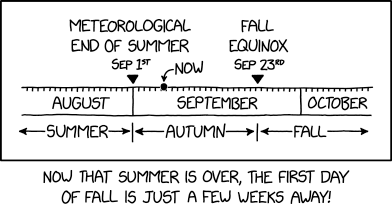Autumn and Fall

Of course in reality this is just a US/UK thing; in British English, 'fall' is the brief period in between and 'autumn' is the main season.

Of course in reality this is just a US/UK thing; in British English, 'fall' is the brief period in between and 'autumn' is the main season.
Autumn, also known as "fall" in the United States (short for 'fall of the leaf'), is the season between the end of summer and the beginning of winter. These terms are used interchangeably, but Randall in this comic treats them as separate seasons. His timeline uses "autumn" as the season between the end of summer and the "fall equinox", and the season of "fall" as the period after that until winter. While many different parts of the world use different ways of reckoning the seasons (eg, a two-season system in the tropics or a six-season system in South Asia), nowhere uses the type of five-season system shown in the comic, nor the extrapolated eight-season system it may even imply.
The comic depicts two of the commonly used boundaries, for any given hemisphere, for the recognized end of summer. While other cultures have adopted yet other dates, according to their own calendars or local experience, Randall may have encountered several other 'standard' methods of dividing the year.
- Some treatments of the seasons (not shown) treat the summer solstice very much as "midsummer", and all other seasons also more or less equally straddling their own equinoxes/remaining solstice, putting the seasonal boundaries half way between each of these astronomically significant points.
- For others, the equinoctial/solstitial dates are used for the changeover time, so that autumn/fall starts upon the equinox (shown) and ends at the astronomically shortest day which is then the start of winter. This system tends to be traditional where the annual warming and cooling of the climate significantly 'lags' the solar calendar.
- Meteorological seasons are handily aligned to months, for administrative reasons. Spring (short for 'spring of the leaf') is March through May, summer across June to August, the September start (to the close of November) is as illustrated, leaving winter to be covered by December and on until the end of the following February. Or shifted round by two of the triples for the southern hemisphere.
- For practical purposes, many in the U.S. treat Labor Day as the unofficial end of summer: this is the day many local pools close for the winter, people start watching football rather than baseball, have their last picnic of the year, etc.
The joke here is that, because Americans do not use the term "autumn" very often in normal communication, someone might be led to believe that it had a special unusual scientific meaning.
The title text makes fun of the transatlantic difference in terms, as it claims one must reverse these two distinct season names. The term "autumn" is, in reality, the word overwhelmingly used in the UK for the season commonly (but not exclusively) referred to as "the fall" in the US, regardless of which of the calendar offsets is to be assumed, and the equinox is, accordingly, called the autumn equinox. "Fall" is rarely used 'natively' in the UK (although it will usually be understood), with the main exception being that it handily allows for the mnemonic of "spring forward, fall back", which uses wordplay to refer to how and roughly when British Summer Time (UTC+1) takes over from the default Greenwich Mean Time (UTC±0).